Decision to create Joint Arab military force and later development
By Ryutaro Minami, Cairo-based journalist
From the Autumn issue of the electronic Salaam Quarterly Bulletin, No.16, November 2015
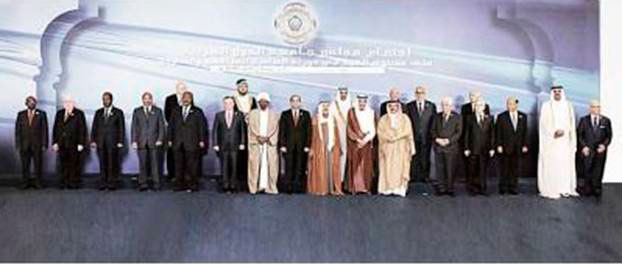
Group photo of the Arab League summit participants in March 2015
The (1) Arab League summit held in the resort city of Sharm el-Sheikh in Egypt’s Sinai Peninsula on March 28 and 29 this year reached an agreement to create a joint military force. The basic policy is to use the force against external danger to Arab countries and not use it in civil war situations. However, difference of opinions among member countries surfaced and coordination has been taking much time. As the result, the joint military force has not been officially launched. Meanwhile, Russia started interfering with Syrian civil war, launching of the force is becoming more urgent.
Egypt facilitating formation of Joint Arab military force
The idea of creating a joint Arab military force was floated in the past. The background which led to an agreement about it this time was beheading of 21 Coptic Christians from Egypt which advocated the joint military force was carried out in Libya by the Islamic State (IS) which declared the establishment of caliphate.
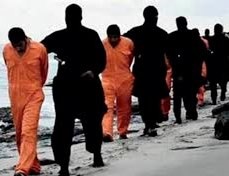
IS killed 21 Egyptian Coptic Christians in Libya.
Egyptian President el-Sisi made a televised speech on February 22 and emphasized, “We are faced with a very serious challenge. A joint military force is indispensable.” He made the speech in response to a video posted on February 15 which depicted Egyptian fishermen who worked as migrant workers in Libya and were abducted in Sirte (Mediterranean coastal city which is Col. Gaddafi’s hometown) in last December and January, outfitted with orange prison uniforms, forced to line up, walk along a beach and kneel down by men in black uniforms with knives in their hands who beheaded them. Substantial number of Egyptian migrant workers are in Libya and similar incidents can occur in the future. Taking that rink into consideration, there was an urgent need for a joint military force.
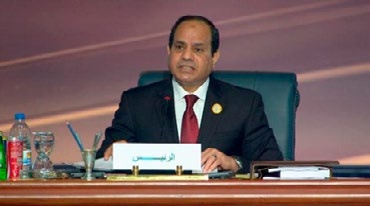
Egyptian President Abdel Fattah al-Sisi says heads of states at the Arab League summit have agreed to the principle of forming a military unit. (31 March 2015, Al Arabiya)
In response to the brutal acts of IS, Egypt carried out retaliatory aerial bombings against IS facilities (training facilities and armories) in Libya on February 18, with approval from the Libyan interim government in Tobruk which is recognized by the international community. Because there were negative reactions toward the aerial bombings in Libya, President el-Sisi had to explain that “IS targets were accurately hit. There was no intention to threaten the sovereignty of Libyan people and people’s life.”
Had a joint military force been established, the bombings would have been considered as a legitimate act for rescuing Egypt’s own citizens through campaigns against IS. President el-Sisi’s defensive explanation would not have been even necessary.
Arab countries supporting the creation of the joint military force are countries threatened by tyrannical acts of IS. Like Egypt, Jordan saw its air force pilot burnt alive by IS. Tunisia lost many citizens to IS who crossed the border and joined IS. In Libya, there are many military training camps established by IS. Persian Gulf countries including Saudi Arabia cannot ignore IS as something unrelated to them. Among Gulf countries, only Qatar objects to the creation of the joint military force. The situation of Iraq and Syria which directly confront IS is even more serious. Syria is currently excluded from the Arab League and is left out in the cold.
Another factor which contributed to decision to create the Joint Arab military force
Another important factor which contributed to the decision to create a joint military force is a dramatic change of the situation of Yemen. After president Ali Abdullah Saleh was removed from the power, the Houthis, a Shiite militia group, tried to control the entire Yemen in an attempt to destroy the new regime led by interim president Abd Rabbu Man sour Hadi. Originally, the Houthis is a militia which belongs to Zaydis, one of Islamic Shiite sects active in the northern area of Yemen. After a Zaydi leader, Hussein Badreddin al-Houthi was killed by the government security forces in September 2004, the group has been called the Houthis. The current leader of the group is Abdul-Malik al-Houthi, a half-brother of Hussein. The official name of the group is Ansar al Allah (Supporters of Allah). President Hadi tried to establish a federal system under a new constitution. The Houthis feared that they may be confined to a mountainous area under a federal system and their influence on the central government may be weakened. It is speculated that the Houthis opposed to the policy of president Hadi because of this.
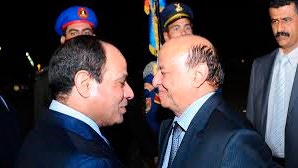
Egyptian President Abdel Fattah al-Sisi welcomes Yemeni counterpart Abd-Rabbu Mansour Hadi at Sharm el-Sheikh, on Friday March 27, 2015. (Presidency handout)
The Houthis expanded its territory into southern Yemen with support from Iran, a Shiite country in 2013. Its forces invaded the Yemeni capital, Sanaa in September 2014. The Houshis demanded resignation of president Hadi, initiated a de facto coup and completely seized power of the government in January 2015.
President Hadi who was under house arrest in the presidential palace in Sanaa secretly escaped from the capital to Aden where he is originally from. He withdrew his resignation on February 21, claiming that “he announced his resignation under pressure from the Houthis.” He stated that “all actions taken by the Houthis are invalid and illegal,” and appealed to the international community to support the transition process he has promoted after his predecessor stepped down in 2012.
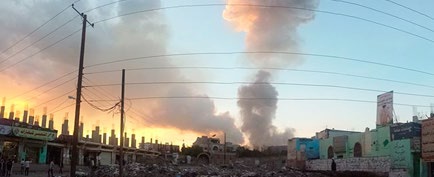
Air strike by Saudi-led coalition forces in Sana’a, Yemen, May 11, 2015 (Wikimedia Commons/Ibrahem Qasim)
In response to president Hadi’s appeal, Saudi Arabia launched aerial bombings to oppose to the Iran-supported Houthis’ rule over Yemen. During the Arab League summit, Saudi Arabia and other Sunni Gulf countries explained about the Yemen situation and agreed to the creation of the Joint Arab military force.
However, Shiite-led Iraq is in a sensitive position and agreed to flexibly respond to actual management of the joint military force based on careful consultations.
Post-Arab League summit
The Houthis forces attacked even Aden which was declared to be the new capital, and president Hadi escaped to and became exiled in Saudi Arabia. However, the coalition forces led by Saudi Arabia gradually pushed back the Houthis forces, reversed the situation and regained control of Aden. President Hadi returned to Aden on September 22, 6 months after he went into exile and visited the presidential office on September 25.
Although the joint military force has not been officially created, the success of the Sunni coalition forces led by Saudi Arabia against Shiite Iran-supported Houthis forces brought the decision on creation of the joint military force closer to the reality.
While the motivation of some countries including Egypt to create the joint military force is to defeat IS, the motivation of Saudi Arabia and others is more to do with defeat of the Shiite power. It is expected that the future management of the force will be based on consensual decision making among those countries.
Current status and challenges of creation of the joint military force
Mohamed Fayaz Falahat, a former research fellow of the Al Ahram Center for Political and Strategic Studies (ACPSS), Egyptian think tank and the secretary general of the Al Ahram Foundation, commented on the current status and challenges in the creation of the joint military force in the middle of September as follows.
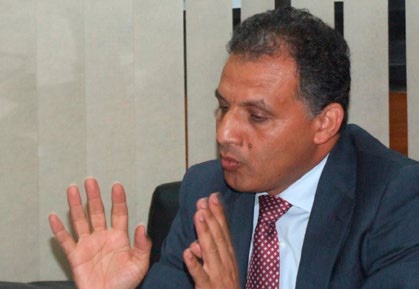
Mohamed Fayaz Falahat, a former research fellow of the Al Ahram Center for Political and Strategic Studies (ACPSS), Egyptian think tank and the secretary general of the Al Ahram Foundation
“The creation of the joint Arab military force has long been floated. But it has never been realized because leaders and elites in those countries feared that they may lose their positions and vested interests in the expanded organization and an economic cooperation system like EU on which a military structure built was lacking. However, the environment drastically changed after the Arab Spring.” He further pointed out, “Existing leaders of the countries lost power and Islamic extremists including IS emerged in Iraq, Syria and Libya and Shiite forces gained power (with interference from Iran) in Yemen. With these developments, the idea to create the joint military force gained momentum.”
Major challenges in creation of the force include (1) the purpose of creating the force (targets of military operations), (2) the size and structure of the force, (3) funding of the force, (4) the military command structure (selection of the commander), (5) the location of the headquarters, and (6) the decision-making process, among others.
He expressed his view, saying, “A consensus was almost reached about (1). The consensus is that the military force is used not to fight against the Shiite forces but to fight external aggressions against the Arab world and environment as well as forces and influences which disturb security of the Arab countries. The United States and the United Nations do not have power to reconstruct the confused Arab world. Without mobilization of the Joint Arab military force, there will be no solution to problems of Arab countries including the problem of Yemen.”
Moreover, with regard to (5), “Egypt is the most viable candidate, but Qatar is against that. Qatar is a small country and has had a tendency to demonstrate its presence historically. Qatar relied solely on the United States to compete with large countries such as Saudi Arabia. Because the Obama administration launched policy to engage in the Middle East centered on the Muslim Brotherhood and Turkey after the Arab Spring, Qatar announced its support for the Muslim Brotherhood in direct confrontation with Saudi Arabia. That is the reason why Qatar is opposed to the idea to set up the headquarters of the joint military force in Egypt. Qatar anticipates that Egypt and Saudi Arabia become the center of management of the joint military force, so the country opposes to the creation of the force itself.”
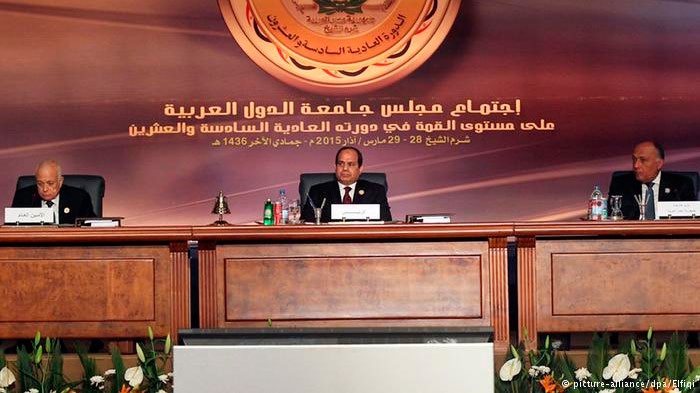
A session of the Arab League summit; Egyptian president el-Sisi at the center
Mohamed Fayaz Falahat further presented his analysis about the view of the countries like Iraq and Lebanon with a large population of the Shiites on the joint military force. He explained, “Because the creation of the joint military force was decided in the discussions of the Arab League, it is not possible to halt the creation of the force. Those countries are worried about the possibility that the force may be used against the Shiites in case a battle starts between the Shiites and the Sunnis in Iraq, for example, in the future. Lebanon has the same concerns.”
Therefore, he concluded, “the joint military force is used only to maintain an official government. For example, the force will be used against the forces that try to bring about collapse of the official government in Libya or Yemen in order to maintain and protect the official government. In other words, the joint force will not be used in civil wars even if doing so will support the government and prevent the country from collapsing. So, the joint military force to overcome challenges to the official governments from IS or Al Qaeda will be welcomed enthusiastically by almost all Arab countries.”
Creation of the joint military force must not be frustrated by Russian intervention in Syrian civil war
If the basic stance of the Joint Arab military force is “not to use the joint force in civil wars,” how do they deal with Syria which is in a de facto civil war?
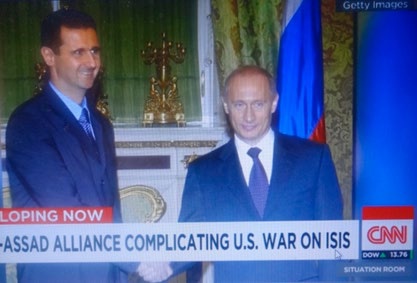
October 06, 2015 What drives the Putin-Assad alliance? (Screenshot)
The United State and European countries are poised to recognize the post-Assad Syrian government. Their stance is that they don’t recognize the Assad regime, but they recognize the nation of Syria. IS which controls vast areas in both Syria and Iraq is out of question in their view. Accordingly, the Western countries organized the Coalition of the Willing to enable direct attacks against IS (2) as long as they are justified from international and humanitarian perspectives without seeking a permission from the Assad regime. Furthermore, in response to another instance of Syrian use of chemical weapons in this summer, the United Nations Security Council unanimously approved the resolution to “establish an investigation committee to identify use of chemical weapons.”

Black smoke billows over Homs in Syria after reported Russian aerial Attack Wednesday morning. (Screenshot)
Russia turned blind eyes to the Western countries’ conscientious efforts on Syria until recently but started to intervene in the Syrian civil war on September 30 in response to Assad regime’s request for support. Saudi Arabia expressed a strong opposition to Russia’s increasing interference with Syria. On the other hand, Egypt saw this as an opportunity to eliminate all Islamic extremists including the Muslim Brotherhood which is active behind Islamic extremists and supported Russia. Those two countries played a leading role in the creation of the Joint Arab military force, but they are divided in their stance toward Russia.
The United State president Obama’s indecisiveness allowed continuation of the Assad regime. It is strongly hoped that the intervention in the Syrian civil war by Russia which took advantage of disarray of the Arab countries does not frustrate the creation of the Joint Arab military force.
Footnote
(1) Arab League
21 countries and one organization are members.
(2) as long as they are justified from international and humanitarian perspectives
The United States’ aerial bombings carried out in August, 2014 to rescue Yazidis, Christian minority in Iraq, the United States’ aerial bombings to support Kurdish minority in Syria, protection of Syrian minority (Druse) from persecution, Syrian-Turkish border control through cooperation with Turkey and support of Kurds on the border area, and military training and arms assistance provided to Syrian rebels who are fighting IS, among others.
More articles available in the electronic “Salaam Quarterly Bulletin”, No.16, November 2015.
